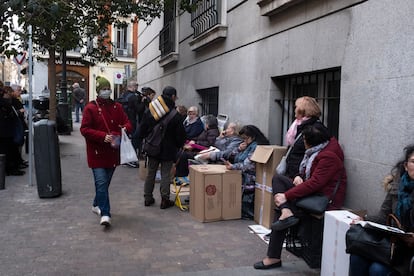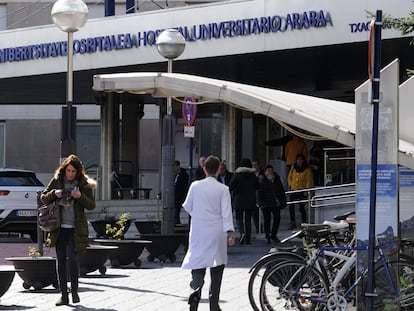No kissing Christ: The coronavirus ban that has upset Madrid’s faithful
The archbishopric of the Spanish capital has ordered worshipers not to kiss the feet of the holy figure in an effort to stop the spread of Covid-19


Pilar Peláez’s glasses fog up. She takes out a microfibre cloth from a rectangular case and wipes them clean. The 59-year-old has holy cards of the Christ of Medinaceli, a wooden statue of Jesus that is located inside the Basilica of Jesus of Medinaceli, in the center of Madrid. She also has medals, stamps and embroidery of the Christ of Medinaceli. Even her WhatsApp profile is a close-up image of Jesus’ face.
Everything she buys, from a cellphone to a blouse, goes past Christ’s feet. This year, she wants to rub the belt from her grandson’s communion outfit across the figure’s feet, and has been waiting a week outside the basilica in a long line of plastic chairs for the chance to do so.
Every time I have asked him for something, he has delivered. I am not going to fail him now. I am stayingPilar Peláez
But the archbishopric of Madrid, following the recommendations of the Spanish Health Ministry, has asked worshipers not to kiss or touch the figure in an effort to stop the spread of the Covid-10 coronavirus.
“It makes me very sad because I have a lot of faith. I am sad,” she says, and her glasses fog up again.
The Jesus statue can be seen from behind a gate in the basilica every day, but it is on the first Friday of March that visitors are allowed to approach the holy figure in person.
Peláez has been waiting in line outside the basilica, on Jesus Street in the Las Letras neighborhood, from morning to night to do this. A friend takes her place at 7pm and sleeps in the line until Peláez comes back in the morning. They talk a bit and swap turns.
They are among 40 women who will pass by the image of the Christ of Medinaceli when the basilica opens, as per tradition, on the first Friday of March.

But the global concern over Covid-19 has deprived them of something they wait all year to do – kiss the feet of Christ. The decision pains their hearts and souls. For Peláez, the ban – which some consider to be just a recommendation – was a very hard blow. Her daughters have asked her to go home and rest, arguing she shouldn’t spend so many hours outdoors. But Peláez believes that now, more than ever, she must have faith and hold out until the moment arrives. “I can’t kiss him. It’s a blow. But every time I have asked him for something, he has delivered. I am not going to fail him now. I am staying,” she says.
The Christ of Medinaceli represents the moment of the Passion when Jesus is presented to the people by Pontius Pilate. He stands inside the basilica with his hands tied together. To reach the figure, you have to walk up a marble staircase on the side of the church. The visitor sees the Jesus statue in profile, as a light from the roof illuminates his face. There is the scent of incense and burned wax, but it’s just an illusion. The flickering red lights are electric candles that are turned on after a coin-donation is made. A woman, with her head against the door of the niche, whispers to herself with her eyes closed. Her husband stands next to her, and looks off absently into the distance. “I come with her to this, and she comes with me to the things that I like,” he explains. They leave a little later, holding hands.
In case asking Catholic faithfuls not to kiss the feet of Christ was not clear enough, the archbishopric included a photo of a woman performing this action with a big red cross through it, to show that it was banned.

Alicia Pompa, 65, takes turns waiting outside the basilica with her brother-in-law. He has asked for a week off from work to be able to wait without the burden of an eight-hour working day. Pompa says that she asks Christ for three wishes, and he usually grants at least one. It is not clear if the power of the wish is diminished if there is no kiss. There are complaints that the tradition, which used to be very local and only practiced by the people in the area, has become a tourist attraction, leading to the endless lines. But, at the same time, it is said that there is less worship. When asked why the number of faithfuls has increased, Pompa responds: “Perhaps because there are more problems in life and people have no one to turn to. There are more and more desperate people.”
English version by Melissa Kitson.
Tu suscripción se está usando en otro dispositivo
¿Quieres añadir otro usuario a tu suscripción?
Si continúas leyendo en este dispositivo, no se podrá leer en el otro.
FlechaTu suscripción se está usando en otro dispositivo y solo puedes acceder a EL PAÍS desde un dispositivo a la vez.
Si quieres compartir tu cuenta, cambia tu suscripción a la modalidad Premium, así podrás añadir otro usuario. Cada uno accederá con su propia cuenta de email, lo que os permitirá personalizar vuestra experiencia en EL PAÍS.
¿Tienes una suscripción de empresa? Accede aquí para contratar más cuentas.
En el caso de no saber quién está usando tu cuenta, te recomendamos cambiar tu contraseña aquí.
Si decides continuar compartiendo tu cuenta, este mensaje se mostrará en tu dispositivo y en el de la otra persona que está usando tu cuenta de forma indefinida, afectando a tu experiencia de lectura. Puedes consultar aquí los términos y condiciones de la suscripción digital.
More information
Últimas noticias
Most viewed
- Alain Aspect, Nobel laureate in physics: ‘Einstein was so smart that he would have had to recognize quantum entanglement’
- David King, chemist: ‘There are scientists studying how to cool the planet; nobody should stop these experiments from happening’
- Maps of the US attack on Venezuela: Targets, airspace and deployed fleet
- Key points of the military attack on Venezuela: Early morning bombings and a ‘captured’ president
- Trump says Washington will control Venezuela until there is ‘a safe transition’










































